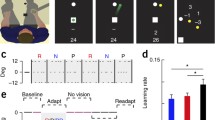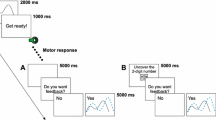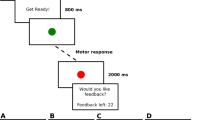Summary
Generally the therapeutical effect of EMG feedback is viewed in terms of the immediate contiguity between response and information. According to this view any feedback delay would deteriorate the result. In this article the validity of this notion has been investigated. Three groups of normal subjects were required to perform a difficult movement under three feedback conditions: immediate EMG feedback, delayed EMG feedback, and a control (no EMG feedback) condition. The results indicated a significant difference between the EMG feedback groups and the control condition. However, no such difference was found between the immediate and delayed feedback conditions. The results suggested that the immediacy of the feedback is not the main factor in EMG feedback, but the specificity of the information.
Similar content being viewed by others
References
Adams, J.A. (1971). A closed loop theory of motor learning. Journal of Motor Behavior, 3, 111–150
Adams, J.A. (1976) Issues for a closed loop theory of motor learning. In G.E. Stelmach (Ed.), Motor control: Issues and trends. New York: Academic Press.
Belanger, A.Y., & Chapman, A.E. (1977). Function and training of the abductor hallucis muscle in cases of mild hallux valgus. Phytiotherapy Canada, 29, 205–210.
Brudny, J. (1982). Biofeedback in chronic neurological cases: therapeutic electromyography. In L. White & B. Tursky (Eds.), Clinical biofeedback: efficacy and mechanisms. New York: The Guilford Press.
Brudny, J., Korein, J., Grynbaum, B., Friedman, L.W., Weinstein, S., Sachs-Frankel, G., & Belandres, P.V. (1976). EMG feedback therapy: review of treatment of 114 patients. Archives of Physical Medicine and Rehabilitation, 57, 55–61.
Delagi, E.F., & Perotto, A. (1980). Anatomic guide for the electromyographer: the limbs. Springfield, Ill: Thomas Publ.
Earnshaw, H.J., Lubbock, G., & Ellis, R.E. (1981). Clinical application of the Exeter Posture Monitor. Physiotherapy, 11, 326–328.
Gottlieb, G.L., Agarwal, G.C. (1970). Filtering of electromyographic signals. American Journal of Physical Medicine, 49, 142–146.
Grynbaum, B.B., Brudny, J., Korein, J., & Belandres, P.V. (1976). Sensory feedback for stroke patients. Geriatrics, 6, 43–47.
Harris, F.A. (1979). Treatment with a position-controlled head stabilizer. American Journal of Physical Medicine, 58, 169–184.
Herman, R. (1973). Augmented sensory feedback in control of limb movement. In W.S. Field & L.A. Leavitt (Eds.), Neural organization and its relevance to prosthetics. New York: Intercontinental Medical Book Corp.
Inglis, J., Campbell, D., & Donald, M.W. (1976). Electromyographic biofeedback and neuromuscular rehabilitation. Canadian Journal of Behavioral Science, 8, 299–323.
Kasser, R.J., & Lehr, R.P. (1979). Electromyographic frequency response of the biceps brachii in an isometric contraction to fatigue. Electromyography & Clinical Neurophysiology, 19, 175–181.
Keefe, F.J., & Surwit, R.S. (1978). Electromyographic biofeedback: behavioral treatment of neuromuscular disorders. Journal of Behavioral Medicine, 1, 13–25.
Keele, S.W. (1981). Behavioral analysis of movement. In V.B. Brooks (Ed.), Handbook of Physiology, Volume II, Motor Control, part 2, Bethesda: American Physiological Society.
Keele, S.W. (1982). Learning and control of coordinated motor patterns: the programming perspective. In J.A.S. Kelso (Ed.), Human motor behavior: an introduction. Hillsdale: Erlbaum.
Mann, R., & Inman, V.T. (1964). Phasic activity of intrinsic muscles of the foot. Journal of Bone and Joint Surgery, 46, 469–481.
Middaugh, S.J. (1978). EMG feedback as a muscle reeducation technique: a controlled study. Physical Therapy, 58, 15–22.
Mulder, Th. (1985). The learning of motor control following brain damage: experimental and clinical studies. Lisse: Swets & Zeitlinger
Mulder, Th., & Hulstijn, W. (1984). Sensory feedback therapy and theoretical knowledge of motor control and learning. American Journal of Physical Medicine, 63, 226–244.
Mulder, Th., & Hulstijn, W. (1985). Sensory feedback in the learning of a novel motor task. Journal of Motor Behavior, 17, 110–128.
Newell, K.M. (1976). Knowledge of results and motor learning. Exercise and Sport Science Reviews, 4, 195–228.
Newell, K.M. (1981). Skill learning. In: D. Holding (Ed.) Human Skills. London: Wiley and Sons.
Roy, E.A., & Marteniuk, R.G. (1974). Mechanisms of control in motor performance: closed loop vs motor programming control Journal of Experimental Psychology, 103, 985–991.
Salmoni, A.W., Schmidt, R.A., & Walter, C.B. (1984). Knowledge of results and motor learning: a review and critical reappraisal. Psychological Bulletin, 3, 355–386.
Schmidt, R.A. (1982). Motor control and learning: a behavioral emphasis. Champaign: Human Kinetics.
Summers, J.J. (1981). Motor programs. In D. Holding (Ed.) Human Skills. London: Wiley and Sons.
Van der Locht, H.M., Van der Straaten, J.H.M., & Vredenbregt, J. (1980). Hybrid amplifier-electrode module for measuring surface electromyographic potentials. Medical and Biological Engineering and Computing, 18, 119–122
Wolf, S.L. (1979). Anatomical and physiological basis for biofeedback. In J.V. Basmajian (Ed.). Biofeedback principles and practices for clinicians. Baltimore: Williams & Wilkins.
Wolf, S.L. (1983). Electromyographic biofeedback applications to stroke patients: a critical review. Physical Therapy, 63, 1448–1455.
Author information
Authors and Affiliations
Additional information
This study was supported by Grant no. 15-35-03 from the Netherlands Organization for the Advancement of Pure Research
Rights and permissions
About this article
Cite this article
Mulder, T., Hulstijn, W. Delayed sensory feedback in the learning of a novel motor task. Psychol. Res 47, 203–209 (1985). https://doi.org/10.1007/BF00309447
Received:
Issue Date:
DOI: https://doi.org/10.1007/BF00309447




